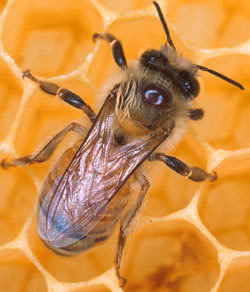|
|
Plato once said: “numbers are the highest degree of knowledge: it is knowledge itself.” By Plato’s standards researchers have just discovered that the honeybee is a knowledgeable insect indeed.
The honeybee can count to three in an instant according to a new study in the online journal PLoS ONE. Using dots and other abstract symbols, scientists from the Vision Centre in Australia tested whether the honey bees had the ability to count items in their environment.
Dr. Shaowu Zhang, Chief Investigator of The Vision Centre and Australian National University, and his scientific team specially created a Y-shaped bee maze to test their subjects. At the front entrance of the maze the bees see a number of particular symbols, such as dots; flying further they are presented with two different pathways. One has the same number of symbols as the first while the other shows a different number. If the bees choose the one that matches the entrance they would be rewarded with sugary water.
 Scientists have discovered the ability of the honey bee to count. |
“This new research shows [bees] can tell the difference between different numbers – even when we change the pattern, shape or the color of the dots!” Zhang said. The researchers intentionally changed the symbols frequently to make certain that they were observing bees counting and not relying on color or pattern for their decision-making process.
In the beginning of the experiments, the bees spent a significant amount of time reading the dots, but once they understood the game researchers were surprised at how quickly they could scan the number and then be on their way.
“Bees can definitely recognise the difference between two, three and four – although four a little less reliably,” Dr. Zhang says. “This is a process known as ‘subitizing’ – which means responding rapidly to a small number of items.”
Numbers after four appear to be beyond the honeybee’s range. When testing the honeybees, the researchers found that they were not able to distinguish between four, five, and six.
Zhang believes the ability of bees to count small numbers helps them with navigation. Honeybees will travel several kilometers from a hive in search of food and return without getting lost. Being able to count landmarks may guide the bees safely home.
“We think the bees are using two memory systems,” Dr. Zhang says. “First is working memory, which they use to recall the number of dots that point to the reward. The second system is to use memory rules. We found this out by changing the pattern of the dots – but the bees still managed to locate the reward.”
Dr. Zhang believes this experiment helps to set insects next to mammals and birds in terms of intelligence.
“There has been a lot of evidence that vertebrates, such as pigeons, dolphins or monkeys, have some numerical competence – but we never expected to find such abilities in insects. Our feeling now is that – so far as these very basic skills go – there is probably no boundary between insects, animals and us.”
Next up is an experiment to see if the honeybees are capable of basic arithmetic. If so, another barrier between humans and insects will come crashing down.
CITATION: Gross HJ, Pahl M, Si A, Zhu H, Tautz J, et al. (2009) Number-Based Visual Generalisation in the Honeybee. PLoS ONE 4(1): e4263. doi:10.1371/journal.pone.0004263
PLoS ONE is a open-access journal. To see the paper: http://dx.plos.org/10.1371/journal.pone.0004263
Related articles
Insect intelligence: paper wasps display strong long-term memory
(11/30/2008)
A recent study in Current Biology finds that paper wasps are capable of remembering rivals a week after initially meeting. As a highly social insect, the discovery proves that the paper wasps’ social interactions are based on applied memory rather than simple instinct. The finding overturns many ideas about the intelligence of insects.
Detecting poisons in nectar is an odour-ous task for honeybees
(04/24/2008)
Though many spring flowers have bright advertisements offering sweet rewards to honeybees, some common flowers have not-so-sweet or even toxic nectars. Why plants would try to poison the honeybees they wish to attract is a scientific mystery. The honeybee, which accounts for the pollination of at least 1/3 of the world’s crop plants, may encounter such poisoned nectar in common crop and garden plants such as Rhododendrons and almond trees.